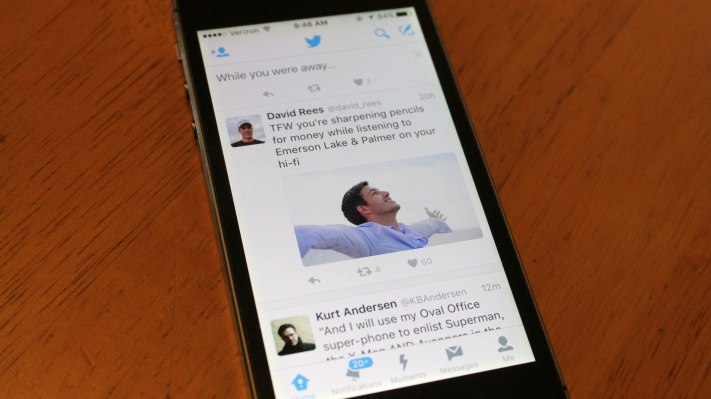Despite reports to the contrary, Twitter’s new algorithmic timeline, announced last month, has only now reached all of Twitter’s user base. That being said, the company does have some early data on how well this updated timeline experience has been performing so far. According to the company, few users are choosing to opt out of having their tweets sorted for them automatically. In fact, the company says that the opt-out rate, since launch, is in the “low single digits.”
In addition, Twitter says that it has seen across-the-board increases in things like per-user favorites, retweets, replies, tweets and daily usage following the new timeline’s debut. Though the company hasn’t shared any hard numbers related to these increases, it’s at least an early sign that making the switch away from presenting tweets in pure chronological order could be working.
In case you missed the fuss, Twitter announced a drastic change in February to the way its service works, designed to encourage growth and activity on its network. The company has been facing stagnant user growth, which has seen its stock hitting all-time lows. This prompted Twitter to rethink some of the core tenets as to how it operates, as well as its overall user experience. Among these was the idea to present a filtered timeline to users which would show recommended tweets at the top, instead of just the most recent ones.
What appears at the top is now determined using a variety of signals, taking into account things like the tweets you interact with, the topics you’re interested in, and the activity of people who are similar to you, among other things.
This is a big change for a network that’s historically been focused on being a real-time feed of information, but not one that’s all that surprising or unexpected. The company had been discussing the possibility of an algorithmic timeline for years.
However, there was some concern that many of Twitter’s older users would rebel against having their timeline configured for them in this way – and that they would quickly opt-out of the new experience. There was even a hashtag of backlash related to this – #RIPTwitter.
[gallery ids="1293719,1293720"]
Twitter made it easy for those not on board with this change to turn it off for themselves, though. In the app’s Settings, a section called “Timeline” offers an option to uncheck the box called “Show me the best Tweets first.” Once disabled, the timeline will appear as it always did.
Of course, until the new timeline remains in place for a long enough period for users to make a decision about whether or not they want to keep it around, we won’t know if Twitter’s early retention and usage data will continue to be as positive as it seems now.
Still, Twitter is hardly the only network to realize the importance of making its feed more engaging to its users. While Facebook obviously pioneered this idea with its algorithmically determined News Feed, other social services are also now making this shift. The latest to announce a move away from chronological posts is Facebook-owned Instagram, which only days ago said that it would begin displaying the best posts first.
Combined, these shifts represent a realization that real-time content and recency aren’t necessarily what makes a service compelling to its users. Instead, what users want to see is interesting content that matters to them…even if it’s a few hours – or even days – old.
edit: Post updated to reflect that the timeline rollout has now completed.
